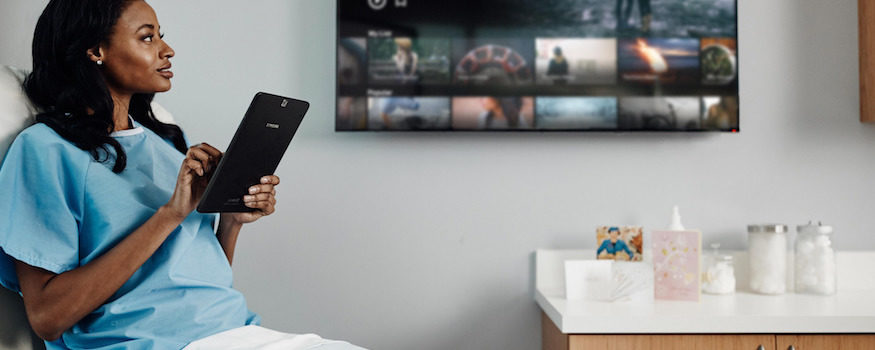Healthcare faces an inflection point as the sector becomes more consumerized and focused on improving the patient experience. Part of this move is driven by patients who expect a certain level of customer service and choice in all of their interactions, even in hospitals. The HCAHPS (Hospital Consumer Assessment of Healthcare Providers and Systems) survey is making an impact, even provoking change and affecting funding by measuring patient impressions of hospital care. With revenue at stake, hospitals are feeling even more pressure to improve the patient experience. One strategy is to rethink the design and technology used in your patients’ rooms to create a more comfortable, open and communicative experience for patients.
Create a VR Healthcare Pain Management Program
Explore the key drivers of using VR for pain management and get tips for implementation. Download Now
Technology and the Hospital of the Future
When Johns Hopkins Hospital held a patient town hall in 2015, they discovered that one of the most common pieces of feedback from patients was that they wanted better and up to date communications about their care. Technology now exists that meets this request, and puts control of care and comfort right where patients want it: in their own hands.
Hospital-grade Smart TVs or tablets create the patient room control center. Rather than dry erase boards that your staff manage manually, smart TVs can automatically show the room phone number, names and photos of your healthcare team and staff, and procedure schedules. It also provides another way for your patients to view their vitals and relevant health information. Devices like these put intelligent room controls at the fingertips of your patients, allowing them to manage their entertainment choices, TV volume, lighting and temperature controls. Smart TVs enable patients to beat boredom, lower anxiety, stay better informed about their own care and even watch videos that educate them on their condition.
But far more than entertainment and atmosphere, hospital room technology vitally connects you to your patients.
For example, Baptist Memorial Health Care launched the MyChart Bedside pilot program that provides longer-term hospital patients with Samsung Galaxy tablets. From the tablets, patients can see their daily treatment schedule, information about both their diagnosis and medication, current vital signs, test results and hospital staff. They can also send direct communication text messages to their doctors and nurses, and even play games. As the Johns Hopkins Hospital town hall revealed, patients crave updated and current information. Busy health professionals often don’t have time to update patients on next steps or care plans. But in the patient room of the future, tools such as this meet that need.
Another undeniable fact of hospital visits is that they often involve patient pain. In order to make the patient stay more comfortable, Southern Hills Hospital in Las Vegas used AccendoWave and Samsung Galaxy tablets to gather pain feedback from patients via a headband. The band measured electrical impulses in the brain to signal discomfort and fed that information to the tablet. Based on pain levels, tablet apps were served to the patient to provide diversionary content that could distract from the pain. The band monitored the brainwaves and feedback to ensure the tool was working.
Improving the patient experience is changing hospital stays, and even hospital care, for the better. As patients continue to look for more involvement within their medical care, from one-day procedures to multi-night hospital stays, your hospital or healthcare facility can rely on technology to usher in the hospital of the future.
Learn more about how healthcare technology solutions can enhance efficiencies and improve the patient experience.









